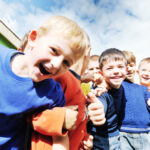I can’t believe it’s been SO long since I posted….life got in the way I’m afraid…too many balls in the air and not enough hands….planning to be back now though. So this is the 3rd post in the series about how early childhood educators can support multilingual children’s language development. These 5 strategies all draw on knowledge of language development and using direct instruction targeting specific linguistic features.
Five things to try are:
- Help children understand connections and differences between their languages by talking about the languages and asking the children about their home languages. This all depends on your context as some chiildren might not like the spotlight being on them. Educators could also learn basic vocabulary in each of the languages spoken in their context and make sure that words in the languages are visible in the rooms
- Teach vocabulary or other linguistic features using each language to discuss and extend children’s ideas as opposed to just teaching vocabulary through direct instruction. Like the first point, you’re working on metalinguistic knowledge here and building connections between the languages.
- Repeating new words and combining them with gestures has been found to be effective for building toddler’s vocabulary so you can remember to use natural gestures to support children’s language comprehension.
- Teaching key vocabulary in parallel in each language. Multilingual children need to have strong support for their home language. If you can’t manage this in yoru preschool, you can work together with parents so they can focus on the vocabulary in the home language.
- Directly model target pronunciation/grammar by repeating words and sentences correctly after the child. Here’s a very quick video explaining how to do this: https://www.youtube.com/watch?v=ptEATK9XIg4
What I read so you don’t have to:
Axelrod Y, Cole MW. ‘The pumpkins are coming…vienen las calabazas…that sounds funny’: Translanguaging practices of young emergent bilinguals. Journal of Early Childhood Literacy. 2018;18(1):129-153. doi:10.1177/1468798418754938
De Houwer, A. & Pascall, M. (2021). Our children and their languages: barriers, needs and opportunities: A proposal for early multilingual education KITA Handbook https://www.kindergartenpaedagogik.de/fachartikel/bildungsbereiche-erziehungsfelder/sprache-fremdsprachen-literacy-kommunikation/unsere-kinder-und-ihre-sprachen-huerden-beduerfnisse-und-chancen/
Gort, M., Pontier, R.W. & Sembiante , S. (2012) Function, Type, and Distribution of Teacher Questions in Dual-Language Preschool Read Alouds, Bilingual Research Journal, 35:3, 258-276, DOI: 10.1080/15235882.2012.734262
Gort, M. & Pontier, R.W. (2013). Exploring bilingual pedagogies in dual language preschool classrooms, Language and Education, 27:3, 223-245, DOI: 10.1080/09500782.2012.697468
Khalfaoui, A., García-Carrión, R., & Villardón-Gallego, L, (2021). A Systematic Review of the Literature on Aspects Affecting Positive Classroom Climate in Multicultural Early Childhood Education. Early Childhood Education Journal, 49: 71-81.
Langaloo, A., Lara, M., Deunk, M., Klitzing, N. & Strijbos, JW. (2019). A systematic review of teacher-child interactions with multilingual young children. Review of Educational Research 89(4): 536-568.
Zheng, Z., , Degotardi, S., & Djonov, E. (2021). Supporting multilingual development in early childhood: A scoping review. International Journal of Educational Research 110.

